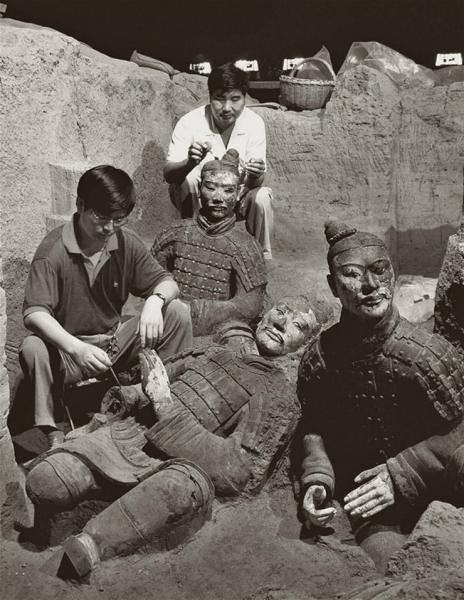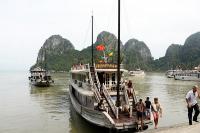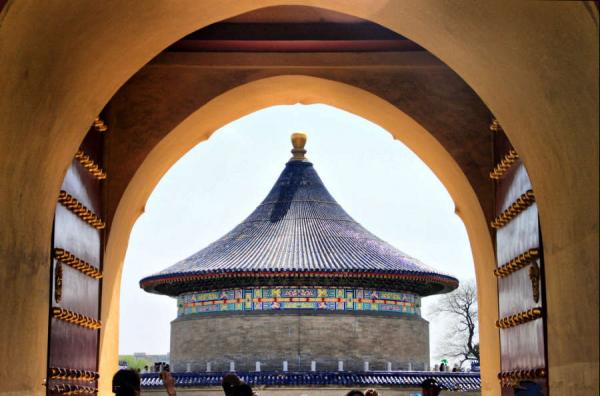Mausoleum of the First Qin Emperor (Tomb of Qin Shi Huang)
The Mausoleum of First Qin Emperor is the largest underground emperor tomb while the pyramids in Egypt is the largest on-ground king mausoleum in the world. Located in the eastern suburbs of Lintong District, 35 kilometers (22 miles) east of Xi'an downtown, the underground palace of the emperor Qinshihuang mausoleum enjoys a perfect Fengshui with Wei River in front and Lishan Mountain towering behind. Moreover, the lay of the land from Lishan to Mount Huashan is shaped dragon-like according to traditional Chinese geomancy and the imperial mausoleum is right at the eye of the dragon. This is why the emperor chose this place.
Tomb of Qin Shi Huang is the first emperor’s mausoleum in the history of ancient China. Its huge scaled, rich burial objects is the top of the emperor’s mausoleum including the famous Terracotta Warriors and Bronze Horses. In 1961, it was listed as a key cultural relic under state protection, and in 1987 it was inscribed in the World Heritage List by UNESCO.
Mausoleum of the First Qin Emperor Facts
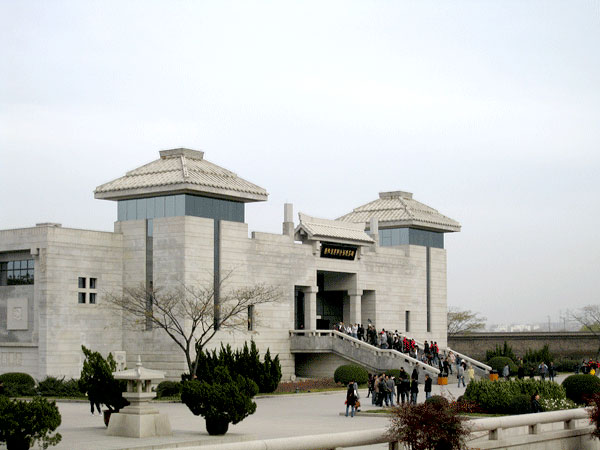
What to See at the Tomb of Qin Shi Huang?
Due to limited archaeological technology, the Mausoleum of the First Qin Emperor has not yet been excavated, and visitors can only see the surface of a tall mausoleum surrounded by mountains and vegetation. But you can visit Terracotta Army, the most important part that has been excavated so far from the Tomb of Qin Shi Huang. Furthermore, go to the site of the underground palace to hear a lot of legends about the first emperor of China.
Stone Armor Pit
Situated between the inner and outer city walls in the southeastern part of the Mausoleum of the First Qin Emperor, Burial Pit K9801 is only approximately 200 meters from the mound. Excavated in 1998, it features a rectangular plan with a main section measuring 130 meters east-west and 100 meters north-south. Including four ramped gateways, the pit covers a total area exceeding 13,000 square meters, making it the largest burial pit discovered within the Tomb of Qin Shi Huang complex to date. Test excavations yielded a large number of densely stacked stone armor pieces (87 sets) and stone helmets (43 pieces), all connected by flat copper wires.
According to the analysis by archaeologists, the production of stone armors should have incorporated the jade processing techniques of that time. Through experiments, it was found that to manually produce an average of 600 pieces of armor, if each person works 8 hours per day at a normal rate, it would take 344 to 444 days. That is to say, it takes one year to produce one piece of armor.
Beyond armor and helmets, archaeologists also uncovered horse armor draped over warhorses and bronze components for chariots and horses. These findings collectively indicate that Pit K9801 functioned as a large-scale “armory.”
Terracotta Warriors Pits
Located 1,500 meters east of the mausoleum complex, the Terracotta Army pits serve as burial sites for Qin Shi Huang's imperial tomb. Discovered in spring 1974 by local farmers digging a well, these pits unveiled the buried army of the Qin emperor—remained underground for over two millennia—and are hailed as the “Eighth Wonder of the World.” Three pits have been excavated so far, yielding over 8,000 terracotta warriors and horses, along with more than 40,000 bronze weapons. These discoveries provide invaluable physical evidence for studying military, political, economic, cultural, and technological aspects of the Qin Dynasty.
>> Recommended Xian tours
Bricks
In May 2025, a special batch of bricks was unearthed from a burial pit at the Mausoleum of the First Qin Emperor. Though identical in size to ordinary bricks, each weighed over 60 jin (approximately 30 kilograms). Archaeological tests revealed a lead content as high as 83% in their composition. Inscriptions on the bricks provided crucial chronological information for archaeological research.
How Mausoleum of the First Qin Emperor was Built
Qin Shi Huang (259 BC - 210 BC) opened the history of Chinese feudal society and created one of the most powerful Chinese dynasties. He was a statesman, strategist and reformer of ancient China. He defeated Han, Zhao, Wei, Chu, Yan and Qi successively, completed the reunification of China, carried out large-scale construction of the Great Wall of China, and established a centralized and unified multi-ethnic state - the Qin Empire. After the unification, he thought that he had made a great achievement, so he named himself “emperor”. He became the first feudal emperor in the history of China and one of the greatest Chinese emperors.
He began the construction of his tomb as early as the age of 13, when he ascended the throne. About 700,000 workers from every province of the empire toiled unceasingly until the death of the emperor in order to construct a subterranean city within a gigantic mound. The project lasted another two years after the death of Qin Shi Huang. Adding the first phase of construction, nearly 40 years were used in building the mausoleum of the First Qin Emperor.
Site Selection
Although Emperor Qin Shi Huang ruled from the capital Xianyang, his mausoleum was constructed on the slopes of Mount Li, far from the city. According to Li Daoyuan of the Northern Wei dynasty, the reason for this choice was: “Emperor Qin Shi Huang undertook grand funeral rites, building his tomb on Mount Li, also known as Lantian. Its northern slopes were rich in gold, while its southern slopes yielded fine jade. The emperor coveted its splendid reputation and thus chose it as his burial site.” Additionally, from the perspective of fengshui, the First Qin Emperor's Mausoleum was situated with Mount Li to the south and the Wei River to the north, making it an exceptionally ideal imperial burial site.
Construction Personnel
Chancellor Li Si served as the mausoleum's designer, while Zhang Han, the Chief of the Imperial Treasury, supervised the construction. A total workforce of 720,000 laborers was mobilized, with the peak number of workers reaching nearly 800,000.
Construction Process
Initial Phase. From the accession of King Ying Zheng to the completion of national unification in the 26th year, the design and main construction of the mausoleum complex commenced.
Intermediate Phase. From unification to the 35th year of Emperor Qin Shi Huang's reign (212 BCE), spanning nine years, this marked the large-scale construction period. Up to 720,000 prisoners labored intensively, essentially completing the tomb complex's main structures.
Final Phase. From the 35th year of Emperor Qin Shi Huang's reign (212 BCE) to the winter of the 2nd year of Emperor Qin Er Shi's reign (208 BCE), lasting over three years, this stage focused primarily on finishing touches and the burial mound's earthwork.
According to the Records of the Historian, the tomb of Qin Shi Huang was very deep and solid and lined with stones. Inside the tomb, a vermilion stone wall blocked off groundwater, making it waterproof; treasures and jewels were kept there and candles of man-fish oil burned 24 hours a day; automatic hidden arrows protected the tomb from robbers and looters and a belt of quicksilver poured in a ditch around the tomb looked like a protective river.
>> Related reading: 7 Oldest Archaeological Sites in China
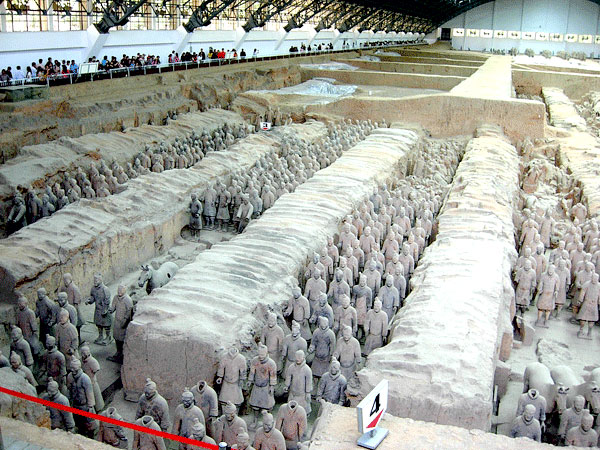
How Big is Mausoleum of the First Qin Emperor: Layout
It is estimated by archaeologists that the whole area of mausoleum is 56.25 square kilometer, which is 78 times of the Imperial Palace of Forbidden City. However, only a part of it was excavated due to the technology limitation of preserving the collections in it. In accordance with the principle of enjoying prosperity and wealth after the death of Emperor Qin Shi Huang, the tomb was built according to the layout of Xianyang, the capital of Qin dynasty. The large ground structures that have been proved in the mausoleum area are the ruins of the sleeping palace, side palace hall and the hall of temple officials.
City Walls
The Mausoleum of the First Qin Emperor features inner and outer city walls approximately 8–10 meters high, with remnants still visible today.
Tomb Mound
The mound of Qin Shi Huang's tomb forms three terraced levels, resembling an inverted pyramid with a nearly square base. During the Qin Dynasty, its base area was approximately 250,000 square meters, standing 115 meters tall. However, after over two millennia of natural erosion and human exploitation, the existing mound has significantly diminished. Its current base area is about 120,000 square meters, with a height of 87 meters.
Underground Palace
The location of the underground palace of Qinshihuang Mausoleum has long been a subject of debate. Remote sensing and geophysical surveys indicate that the underground palace lies directly beneath the mound. Square in shape, it serves as the central structure of the entire complex, housing the coffin and burial artifacts. Archaeological findings indicate the underground palace covers approximately 180,000 square meters, with a central depth of about 30 meters. It measures 170 meters east-west and 145 meters north-south. The burial chamber, situated at the palace's center, stands 15 meters tall and spans an area equivalent to a standard soccer field.
Palace Walls
In 2003, Duan Qingbo, head of the Qin Shi Huang Mausoleum Archaeological Team, announced the discovery of a thick, finely compacted earthen wall encircling the burial chamber beneath the mound—the so-called palace walls. After verification, the palace wall was approximately 168 meters long from east to west and 141 meters from north to south. The southern wall was 16 meters wide and the northern wall was 22 meters wide. The palace wall was made by compacting multiple layers of fine soil, each layer being about 5-6 centimeters thick, which was extremely delicate and sturdy.
Palace Complex
Ten city gates have been discovered at the Tomb of Qin Shi Huang, with the north and south gates aligned along the same central axis as the southern gate of the inner enclosure. The northern side of the burial mound forms the core area of the mausoleum complex. Tomb passages lead to the burial chamber from the east, west, and north sides. Additionally, four parallel architectural remains stand on the east and west sides, which experts believe may be part of the sleeping palace complex.
Since 2010, archaeologists exploring the northwest inner city of the Qin Shi Huang Mausoleum complex have uncovered a vast rectangular ten-courtyard palace complex resembling the Forbidden City. Overall, it measures approximately 690 meters north-south and 250 meters east-west, covering an area of 170,000 square meters—one-fourth the size of the Forbidden City in Beijing.
North of the mound of Qin Shi Huang's Mausoleum, three large palace complex sites were discovered and making contributions for the research of Chinese architecture. Spanning approximately 750 meters north-south and 250 meters east-west, they cover 187,500 square meters. Characterized by dense construction and grand scale, these sites represent the ceremonial structures—specifically the mausoleum complex—within the imperial tomb complex.
How to Get to Tomb of Qin Shi Huang?
No subway to take.
You can take Bus 306, 307 or Sightseeing Bus 5 to Terracotta Army Museum (Bing Ma Yong) Station. During your travel in Xian, after visiting Terracotta Warriors Museum, you can stroll around the Mausoleum of First Qin Emperor.
